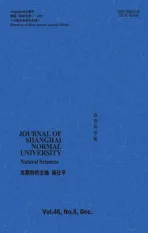非稀土金属及合金化合物改性烧结NdFeB磁体的研究进展
2018-01-11朱明原胡业旻金红明李文献
吕 蒙, 孔 拓, 朱明原, 胡业旻, 金红明, 李文献, 李 瑛
(上海大学 材料科学与工程学院 微结构重点实验室,上海 200072)
非稀土金属及合金化合物改性烧结NdFeB磁体的研究进展
吕 蒙, 孔 拓, 朱明原, 胡业旻, 金红明, 李文献*, 李 瑛*
(上海大学 材料科学与工程学院 微结构重点实验室,上海 200072)
研究发现,烧结钕铁硼(NdFeB)磁体的矫顽力(HC)、腐蚀性与晶界相成分、微观结构息息相关.传统熔炼添加重稀土元素虽可改善晶界相提高磁体的HC及抗蚀性,但同时也使添加物均匀地分布于主相,引起稀磁效应并使成本增加.通过晶界添加非稀土物质调控磁体晶界相,可优化晶界相微观结构,提高其电极电位及润湿性,从而在磁体HC和耐蚀性得以改善的同时,降低磁体中重稀土元素的用量及成本.对近些年晶界添加非稀土金属及合金化合物调控烧结NdFeB晶界相成分、微观结构及其对磁体HC、抗蚀性影响的部分研究进行了归纳.
烧结NdFeB; 晶界扩散; 矫顽力; 抗蚀性; 微观结构; 非稀土金属及合金化合物
0 前 言
1983年日本住友特殊金属公司首次制备出钕铁硼(NdFeB)永磁体[1],由于其具有远高于其他磁体的磁性能且不含贵稀土元素Sm及战略性元素Co[2],显著降低了磁体成本,并逐步发展成为应用最广的稀土永磁材料,被广泛应用于电子通讯、电动汽车、医疗设备、风力发电等高新技术领域[3-4].进入21世纪,电动/混动汽车、风力发电等低碳行业的迅速发展进一步推动了高性能永磁材料,特别是NdFeB永磁体的应用[5-6].但同时也对NdFeB永磁材料的性能提出了更严格的要求,需要其具有更高的矫顽力(HC)和耐蚀性以满足在复杂(高温、高湿等)环境中的应用[7-9].
HC是烧结NdFeB磁体最重要的磁性能参数之一.烧结磁体的HC主要由Nd2Fe14B主相及其晶粒边界处的反磁化畴形核场所决定,形核场低,则磁体的HC就低.由于烧结NdFeB磁体主相晶界处的成分与晶粒内部不一致以及晶界相分布不均等原因,引起磁体边界层反磁畴形核场降低,导致磁体HC较低,温度稳定性较差,其磁性能会随着温度的升高急剧降低,影响其应用[10].改善磁体温度稳定性的措施是提高其各向异性场(HA)及HC,通常是引入重稀土元素Dy[11].研究发现,熔炼添加重稀土元素Dy,虽可在磁体主相晶粒外围形成HA更高的(Nd,Dy)2Fe14B相,从而使磁体HC提高[12-13],但Dy同时也均匀地分布在主相Nd2Fe14B内部.根据Durst等[14-17]提出的烧结NdFeB的HC机制可知,反磁化畴形核主要发生在主相Nd2Fe14B晶粒边界的弱磁性区,Dy的均匀分布导致重稀土元素添加量显著增加(最高可达稀土总量的30%),不仅增加了生产成本且易引起磁稀释效应[18-19].
烧结NdFeB磁体主要由主相Nd2Fe14B、晶界富Nd相、少量富B相组成,其中,Nd是NdFeB磁体中最活泼的金属元素,易与空气中的氧和水发生反应,生成Nd2O3和H2[20].烧结NdFeB磁体抗蚀性较差的原因主要在于晶界富Nd相电极电位(约为-0.65 V)远低于主相Nd2Fe14B的电极电位(约为-0.515 V),易在磁体内形成较大的电极电位差;且晶界富Nd相仅占磁体的10%~15%[21-23],含量远远低于主相,在高温、高湿的腐蚀环境中,易形成具有小阳极(富Nd相)大阴极(主相)特性的原电池[24-26],导致阳极富Nd相的电流密度远大于阴极主相,加速了晶界富Nd相的腐蚀,致使主相Nd2Fe14B晶粒脱落,磁体磁性能急剧降低[27-28].
由此可见,NdFeB磁体的HC、耐蚀性与磁体晶界相成分及微观结构密切相关.为提高磁体HC及耐蚀性,研究人员通过晶界添加非稀土金属及合金化合物调控烧结NdFeB磁体晶界相微观结构,增强晶界富Nd相的稳定性,提高晶界相电极电位、润湿性,促进其均匀分布,加强晶界对主相的隔离能力.本文作者总结了近些年国内外晶界添加非稀土金属及合金化合物调控烧结NdFeB磁体晶界相微观结构及其与磁体HC、抗蚀性等方面的部分研究成果,为制备高HC、高耐蚀性烧结NdFeB磁体提供参考.
1 非稀土金属及合金化合物改善烧结磁体矫顽力
Knoch等[29]和Yan等[30]研究结果表明低熔点元素Al的晶界添加,使磁体HC由8.9 kOe提高到10.7 kOe,剩磁仅轻微降低.因为Al元素易与磁体晶界富稀土相反应生成Fe-Nd-O-Al新相,且新相中的Fe浓度小于初始磁体富稀土相(Fe-Nd-O)中的Fe浓度,具有较低的磁导率,减小了主相Nd2Fe14B间的磁交换耦合[31].此外,低熔点元素Al呈液相扩散进入晶界提高了主相-晶界相间的润湿性,促进了晶界相的均匀分布[32].
Hu等[33-34]利用低压等离子喷涂技术(LPPS)使Zn沿NdFeB晶界扩散,通过透射电子显微镜(TEM)分析发现(图1),Zn沿晶界扩散使富稀土相中的Fe向外运动与Zn反应生成Zn-Fe化合物.由于Fe向外扩散的速率大于Zn向晶界相内扩散的速率,使富钕相中的钕浓度增高,提高了晶界相的去磁交换耦合作用[35-36].Zn在扩散过程中轻微溶于主相Nd2Fe14B,可替代主相中Fe形成Nd-Fe-Zn化合物,被替代的Fe向晶界移动继续与Zn反应形成Zn-Fe化合物,使晶界厚度增加(图2).

图1 Zn扩散后样品的TEM图.N:晶界富Nd相;Φ:主相Nd2Fe14B;B1:Nd-Fe-Zn化合物;B2:Zn-Fe化合物[33]

图2 Zn沿晶界扩散示意图.(a) 初始磁体;(b) Nd-Fe-Zn化合物形成;(c) Zn-Fe化合物形成[33]
Lin等[37]和Kianvas等[38]研究发现,晶界添加Cu使烧结态NdFeB磁体HC下降,主要归因于游离态α-Fe和Nd2Fe17软磁相的形成.但经回火后,磁体中游离态α-Fe和Nd2Fe17软磁相消失,晶界相分布均匀,表明合适的热处理温度可有效提高磁体晶界相的润湿性[39].根据Miedema公式[40]计算可知,Cu与Nd、Fe、B三种元素的混合焓(△Hmix)分别为-31 kJ/mol、+18 kJ/mol、+2 kJ/mol(+原子间相排斥、-原子间相结合).其中Cu与Nd的△Hmix最小,易与晶界富Nd相作用形成NdCu、NdCu2等新相,新相的形成有利于增强晶界相的钉扎能力,抑制主相晶粒长大[41-42].
Kim等[43]和Fukagawa等[44]探究了不同Cu浓度对烧结磁体晶界相转变温度和微观结构的影响,发现随着Cu浓度(原子百分数为0.2%~0.5%)的增加磁体晶界相转变温度和HC降低.但经790~850 ℃热处理后,HC由28.7 kOe提高至29.4 kOe(原子百分数为0.5% Cu),适宜的热处理温度使磁体主相间三叉交汇区的富稀土相由密排六方(hcp-Nd2O3)结构转变为Ia3空间群结构(Ia-Nd2O3)(图3),降低了主相-晶界相间的晶格畸变.
Cui等[45]探究了Ni对烧结NdFeB磁体晶界相结构和成分的影响,发现晶界添加质量百分数为0.3%的Ni粉,磁体HC增加了12.3%.因为Ni的熔点(1 445 ℃)较高,Ni颗粒在主相表面富集并阻碍了主相晶粒的生长,使晶粒表面缺陷减少,降低了局部退磁场,抑制了反磁化畴形核,磁体HC增加.通过扫描电子显微镜(SEM)进一步分析发现(图4),Ni的添加使晶界相分布更加均匀,晶界更加平直、光滑,减少了反磁化畴形核场所[46].

图3 添加原子百分数为0.5% Cu样品的TEM图.(a) 三叉区富Cu相;(b) 三叉区富Cu相高分辨透射电子显微镜(HRTEM)和电子衍射花样(SADP)图;(c) 晶界富Nd相HRTEM图;(d)晶界富Nd相SADP图[43]
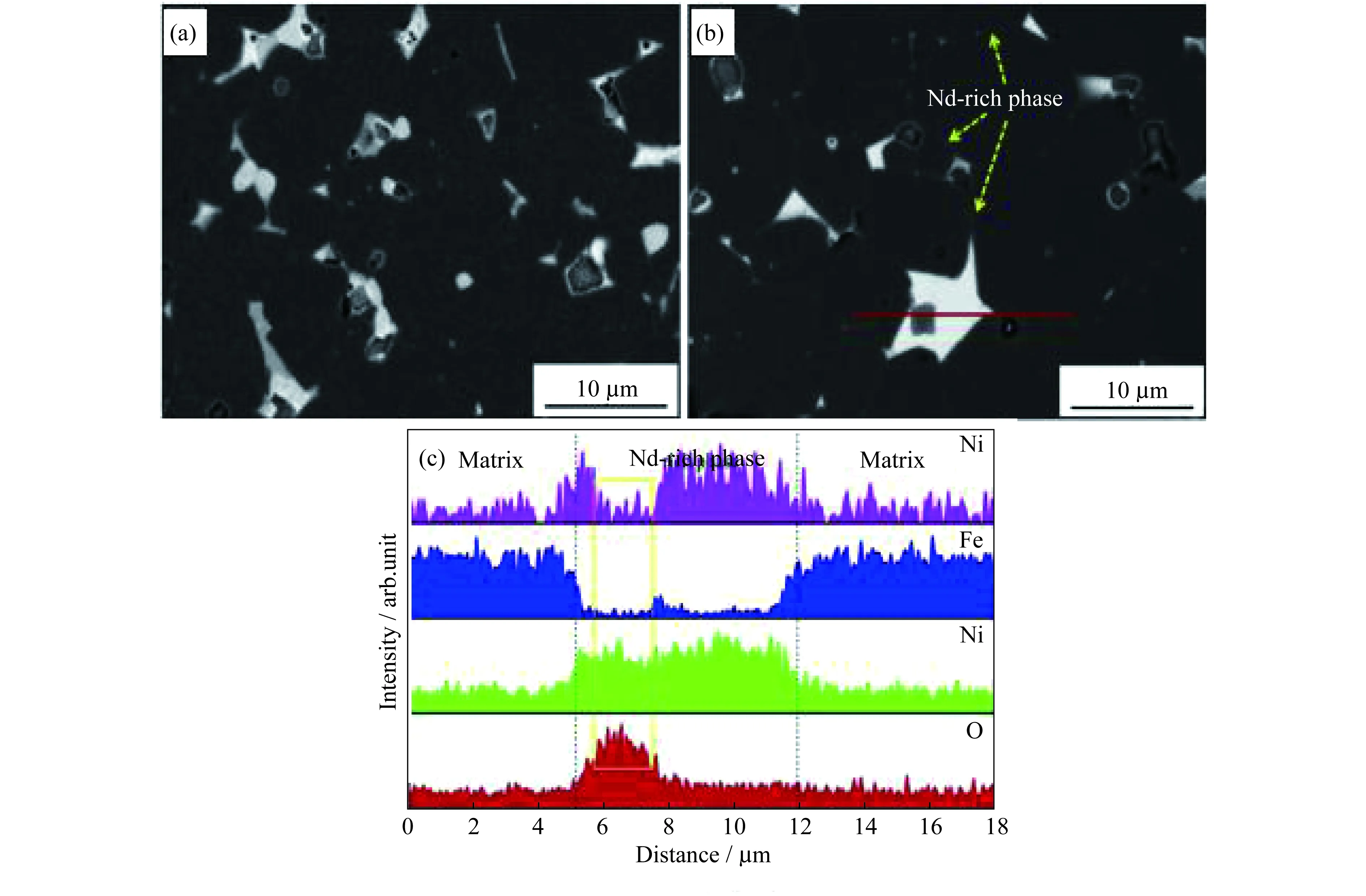
图4 含Ni质量百分数不同的样品SEM图.(a) 0% Ni;(b) 3% Ni;(c)是(b)中标记线上Nd、Fe、Ni和O的分布图[45]
Mural等[47]研究了高熔点化合物碳化钛(TiC)对烧结磁体晶界相微观结构和HC的影响,TiC化学性质稳定,在烧结和热处理过程中既不与富稀土相发生反应也不溶于主相,而是以夹杂物的形式存在于主相-晶界相间隙,起到细化主相晶粒、钉扎畴壁的作用[48-49].
Chen等[50]将质量分数为2%的氧化镁(MgO)粉末与NdFeB磁粉球磨混合,经扩散处理后磁体HC由17.0 kOe增加到22.1 kOe.研究发现,晶界添加的MgO与晶界富稀土相反应生成Fe-Nd-O-Mg新相,新相的产生加强了晶界相对畴壁的钉扎效果,更有效地抑制磁畴反转.
Zhou等[51]利用磁控溅射工艺研究了MgO的扩散对烧结NdFeB微观结构的影响,发现MgO的晶界扩散使主相Nd2Fe14B晶粒边缘突出的尖锐部分明显减少,晶界相分布更加均匀,主相晶粒间普遍存在连续的薄带状晶界富稀土相(图5),有效降低了磁体的退磁因子和主相间的磁交换耦合,并限制了主相晶粒的异常长大,使磁体HC增加[52-53].

图5 初始磁体表层SEM图.(a) 磁体表层(b) 低倍SEM;(e) 表层背散射(BSE),MgO扩散后磁体表层SEM图:(c) 低倍SEM;(f) 高倍SEM;(d) 心部BSE图[51]
2 非稀土金属及合金化合物改善烧结磁体抗蚀性
Li等[54]研究了纳米Mg粉的晶界添加对烧结磁体耐蚀性能的影响.发现随着Mg含量的增加,磁体在质量分数为0.005% H2SO4(或3.5% NaCl)电解质溶液中的腐蚀电位(Ecorr)由-0.652 V(-1.077 V)增加到-0.475 V(-0.847 V),腐蚀电流密度(icorr)由193.1 μA/cm2(54.03 μA/cm2)减小到46.5 μA/cm2(9.36 μA/cm2)(图6),更高的Ecorr和更低的icorr表明磁体电化学稳定性提高.利用SEM分析发现,Mg与晶界富Nd相反应生成化学性质更稳定的Mg-Nd新相,提高了晶间的电化学势[55].
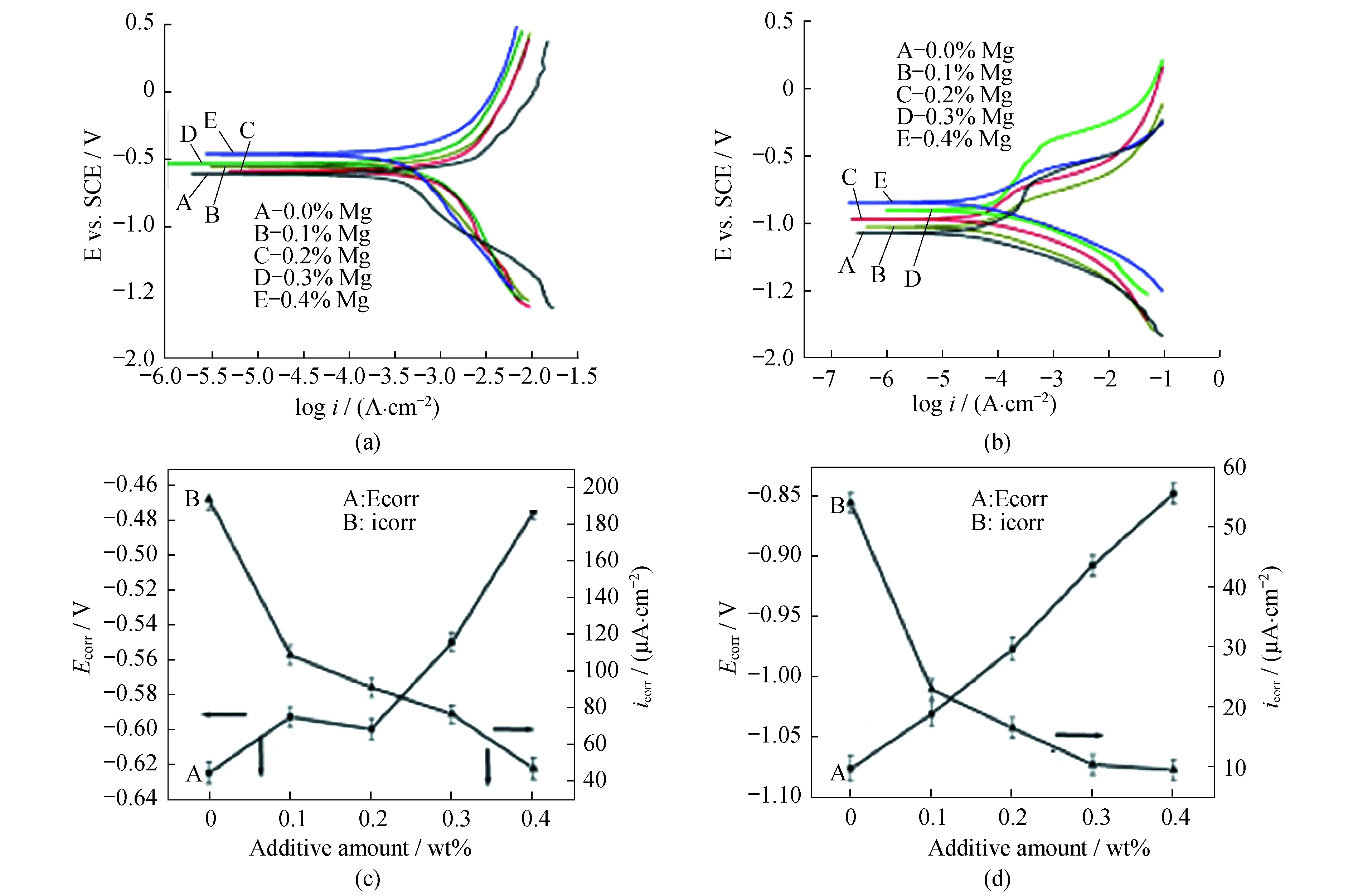
图6 磁体的极化曲线.(a) 质量分数0.005% H2SO4溶液中;(b) 质量分数3.5% NaCl溶液中;(c) 磁体在H2SO4溶液中的腐蚀电位和腐蚀电流密度;(d) 磁体在NaCl溶液的腐蚀电位和腐蚀电流密度[54]

图7 磁体磁性能与CuZn5粉末含量的关系[56]
Wang等[56]研究了晶界添加不同含量的CuZn5粉末对NdFeB烧结永磁体耐蚀性和HC的影响.发现随着CuZn5含量的增加,磁体的剩磁(Br)、HC和最大磁能积(BH)max逐渐减少(图7).
作者进一步探究了不同添加量(质量分数为0%、3.5%、6%)的CuZn5合金对磁体抗蚀性的影响,发现随着CuZn5合金含量的增加,磁体在体积分数为0.1% H2SO4(或蒸馏水)电解质溶液中的Ecorr由-722.43 V(-632.08 V)增加到-700.00 V(-594.92 V),icorr由457.09 μA/cm2(4.27 μA/cm2)减小到419.66 μA/cm2(3.63 μA/cm2)(图8).晶界添加CuZn5合金使磁体具有更高的Ecorr和更低的icorr,是因为Cu、Zn均为低熔点元素在烧结和热处理过程中沿晶界扩散并与晶界富Nd相反应形成Nd-M(M为Cu、Zn)相,降低了晶界相活性,提高了其电化学势,有效抑制了磁体的晶间腐蚀[57].

图8 添加质量分数为0%、3.5%和6.0% CuZn5的烧结Nd-Fe-B磁体的极化曲线.(a) 蒸馏水;(b) 体积分数为0.1% H2SO4溶液[56]
Pan等[58]研究了Cu/Zr共同添加对烧结磁体耐蚀性及HC的影响.发现添加质量分数为0.15% Cu和0.85% Zr使磁体HC由25.14 kOe提高到27.41 kOe(图9),Ecorr由-0.799 V急剧增加到-0.697 V(图10),磁体HC和耐蚀性能明显提高.这可能是添加的低熔点金属Cu与晶界富Nd相反应生成含Cu富Nd相,减小了晶界相与主相间的极化电位差,抑制了磁体的晶界腐蚀.同时Cu/Zr的共添加也提高了主相-晶界相间的润湿性,使晶界变的更加平滑,加强了对主相的包裹能力,使磁体HC提高[59-60].

图9 磁体的退磁曲线.(a) 初始磁体;(b) 添加质量分数为0.15% Cu和0.85% Zr的磁体;(c) 质量分数为1.0% Zr的磁体[58]
Zhang等[61]研究了Cu/Nb共同添加对烧结磁体耐蚀性的影响.发现添加质量分数为0.2% Cu和0.8% Nb的磁体,其Ecorr在质量分数为3.5% NaCl电解质溶液中由-1.115 V增加到-0.799 V,icorr由62.33 μA/cm2减少到12.28 μA/cm2(图11),抗腐蚀能力明显提高.因为Nb的标准电极电位(-1.100 V)和Cu的标准电极电位(+0.337 V)均大于Nd的-2.431 V,减小了晶界富Nd相与主相间的电极电位差.
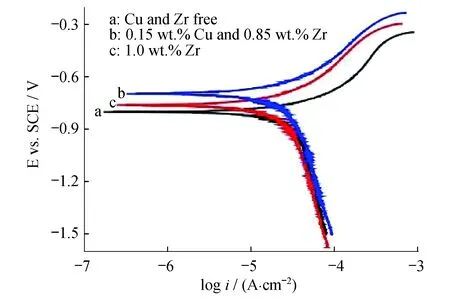
图10 磁体在质量分数为2.5% NaCl水溶液中的极化曲线[58]

图11 样品在质量分数为3.5% NaCl溶液中的极化曲线[61]
进一步通过SEM分析可知(图12,13),Cu在晶界处富集并与晶界富Nd相反应形成Nd-Cu新相,降低了晶界富Nd相的熔点,促进其沿晶界扩散,分布更加均匀.而Nb进入Nd2Fe14B主相,减少了主相和富Nd相的电位差,降低了腐蚀驱动力.同时含Cu富Nd相和Nb-Fe相的形成降低了晶界富Nd相的体积分数,也有利于磁体耐蚀性的增加[62].
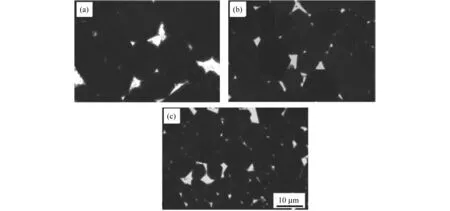
图12 添加Cu、Nb后磁体的SEM图.(a) 初始磁体;(b) 添加质量分数为0.2% Cu和0.8% Nb的磁体;(c) 添加质量分数1.0% Nb的磁体[61]
涂少军等[63]研究发现晶界添加质量分数为0.1%纳米氮化铝(AlN)粉,可使烧结NdFeB磁体在质量分数3.5% NaCl电解质溶液中的Ecorr由-0.673 V增加到-0.573 V,icorr由413 μA/cm2减少到222 μA/cm2(图14).因为晶界添加AlN有效阻碍了Nd2Fe14B主相晶粒的长大,起到细化晶粒的作用,从而使晶界体积分数增加,晶界富Nd相厚度降低,导致磁体的晶间腐蚀通道变窄[64],提高了磁体的耐蚀性.
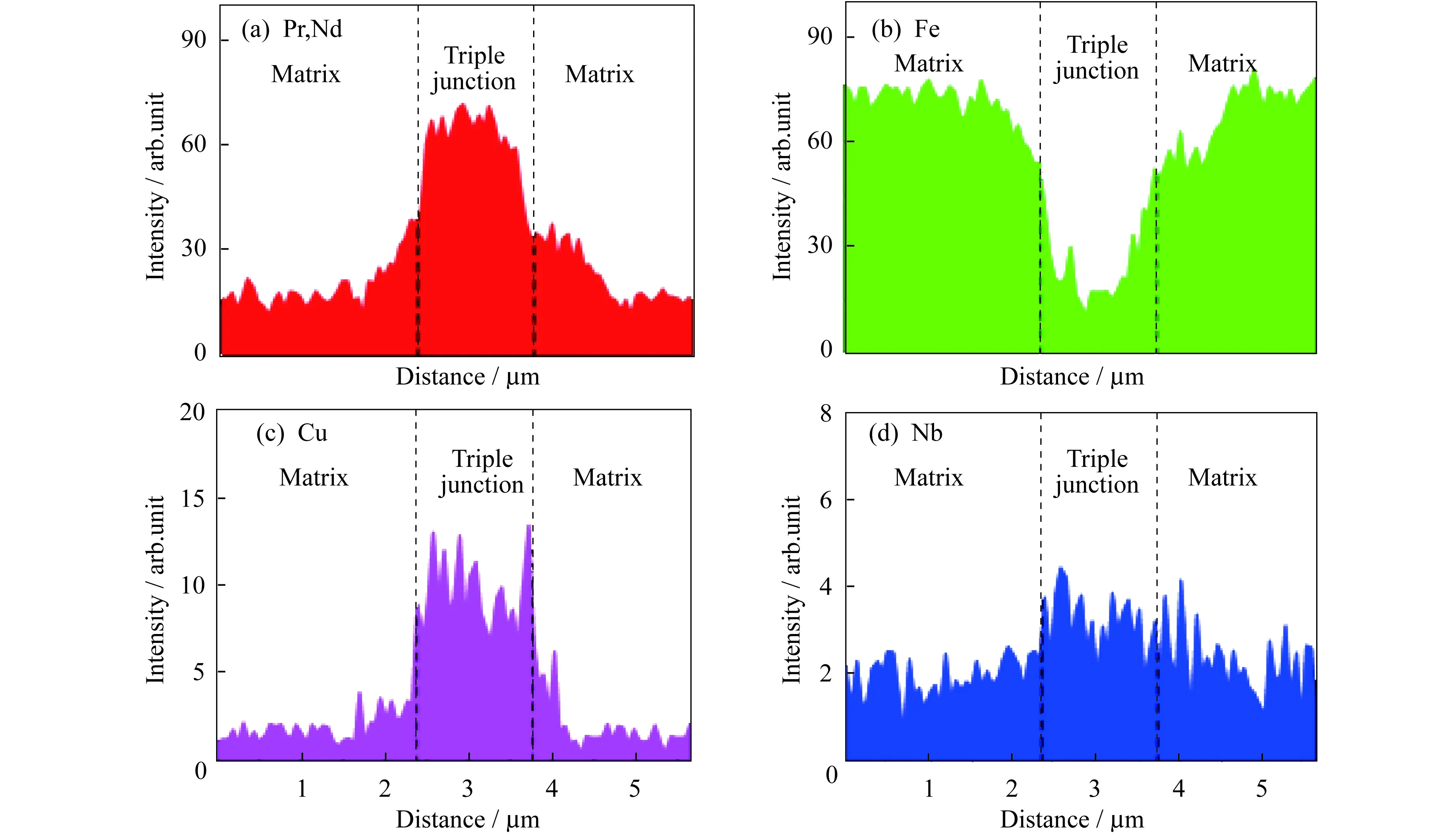
图13 图7(b)画线处的元素分布图[61]

图14 添加不同含量AlN磁体的极化曲线[63]

图15 添加不同含量SiO2磁体的极化曲线[65]
Cui等[65]探究了晶界添加不同含量SiO2对烧结NdFeB磁体耐蚀性的影响.发现磁体在质量分数3.5% NaCl电解质溶液中的极化曲线(图15)随着SiO2含量的增加,磁体Ecorr先增加后减小,而icorr先减小后增大,在添加质量分数为0.01% SiO2时达到最优,Ecorr和icorr分别为-0.595 V和279.6 μA/cm2(添加质量分数为0% SiO2时,Ecorr和icorr分别为-0.676 V和700.6 μA/cm2),降低了磁体的腐蚀速率.SiO2的晶界添加有效优化了富Nd晶界相的理化特性,提高了晶界富Nd相的化学稳定性,且Si在扩散过程中进入富Nd相提高了其电极电位,使主相与晶界相间的电位差减小,有效降低了腐蚀驱动力.
3 总 结
晶界相改性是提高烧结NdFeB磁体磁性能及耐蚀性的主要途径.非稀土晶界添加物经适宜的热处理/扩散处理后,可起优化、修饰烧结NdFeB磁体晶界相组成、微观结构并改善其理化特性的作用,使磁体主相-晶界相间浸润性增加、晶格错配度降低,晶粒尺寸减小,晶界富Nd相电极电位及化学稳定性提高,从而提高了磁体的HC及耐蚀性.
[1] 胡文艳.钕铁硼永磁材料的性能及研究进展 [J].现代电子技术,2012,35(2):152-155.
Hu W Y.Property and research progress of NdFeB permanent magnets [J].Modern Electronics Technique,2012,35(2):152-155.
[2] 钟明龙,刘徽平.我国钕铁硼永磁材料产业技术现状与发展趋势 [J].电子元件与材料,2013,32(10):6-9.
Zhong M L,Liu H P.Industrial technology situation and development trends of Nd-Fe-B permanent magnetic materials in China[J].Electronic Components and Materials,2013,32(10):6-9.
[3] 周寿增,董清飞.超强永磁体:稀土铁系永磁材料 [M].北京:冶金工业出版社,1999.
Zhou S Z,Dong Q F.Super permanent magnets RE-Iron based permanent materials [M].Beijing:Metallurgical Industry Press,1999.
[4] 罗阳.NdFeB磁体市场的大趋势 [J].磁性材料及器件,2002,33(1):10-17.
Luo Y.Trend of NdFeB magnet business [J].Journal of Magnetic Materials and Devices,2008,39(6):9-18.
[5] 崔熙贵,王兴华,崔承云,等.烧结钕铁硼的晶界扩散改性、结构与性能研究进展 [J].稀有金属,2014,38(6):284-290.
Cui X G,Wang X H,Cui C Y,el al.Research progress on grain boundary diffusion modification,microstructures and properties of sintered Nd-Fe-B magnets [J].Journal of Rare Metals,2014,38(6):284-290.
[6] 潘树明.强磁体-稀土永磁材料原理、制造与应用 [M].北京:化学工业出版社,2011.
Pan S M.Principle,manufacture and application of strong magnet-rare earth permanent magnet [M].Beijing:Chemical Industry Press,2011.
[7] 林河成.我国烧结钕铁硼永磁体的高速发展 [J].上海有色金属,2009,27(4):33-38.
Lin H C.Rapid develpment of permanent magnets of sintered NdFeB alloy in China [J].Shanghai Nonferrous Metals,2009,27(4):33-38.
[8] 林河成.我国烧结钕铁硼永磁材料生产应用现状及发展前景 [J].稀土,1999,20(6):70-74.
Lin H C.Sintered NdFeB Permanent Magnet Materials in China [J].Chinese Rare Earths,1999,20(6):70-74.
[9] 罗阳.全球NdFeB磁体产业变化与发展的25年 [J].磁性材料及器件,2008,39(6):9-18.
Luo Y.Twenty five years development of global NdFeB magnets industry [J].Journal of Magnetic Materials and Devices,2008,39(6):9-18.
[10] 闫阿儒,刘壮,郭帅,等.稀土永磁材料的最新研究进展 [J].金属功能材料,2017,24(5):5-16.
Yan A R,Liu Z,Guo S,el al.Recent researchdevelopment of rare-earth permanent magnetic materisls [J].Metallic Functional Materisls,2017,24(5):5-16.
[11] 崔熙贵.烧结 Nd-Fe-B 永磁材料显微结构优化与性能研究 [D].杭州:浙江大学,2009.
Cui X G.Study on microstructure optimization and properties of sintered Nd-Fe-B permanent magnetic materials [D].Hangzhou:ZhejiangUniversity,2009.
[12] 徐芳.晶界结构和晶界化学对NdFeB材料矫顽力的影响 [D].上海:上海交通大学,2011.
Xu F.Effects of grain boundary structure and chemistry on the coercivity of NdFeB materials [D].Shanghai:Shanghai Jiao Tong University,2011.
[13] 莫文剑.烧结NdFeB永磁材料的晶界相改性及其显微结构 [D].上海:上海交通大学,2011.
Mo W J.Modification of the intergranular phase and its microstructure in NdFeB sintered magnets [D].Shanghai:Shanghai Jiao Tong University,2008.
[14] Durst K D,Kronmüller H.The coercive field of sintered and melt-spun NdFeB magnets [J].Journal of Magnetism and Magnetic Materials,1987,68(1):63-75.
[15] Ramesh R,Thomas G,Ma B M.Magnetization reversal in nucleation controlled magnets.II.Effect of grain size and size distribution on intrinsic coercivity of NdFeB magnets [J].Journal of Applied Physics,1988,64(11):6416-6423.
[16] Ramesh R,Srikrishna K.Magnetization reversal in nucleation controlled magnets.I.Theory [J].Journal of applied physics,1988,64(11):6406-6415.
[17] Fukuno A,Hirose K,Yoneyama T.Coercivity mechanism of sintered NdFeB magnets having high coercivities [J].Journal of Applied Physics,1990,67(9):4750-4752.
[18] 周庆.烧结NdFeB永磁晶界结构和晶界相调控及其对性能的影响 [D].广州:华南理工大学,2016.
Zhou Q.Grain boundary structure and grain boundary phase modifications and their effects on properties of sintered NdFeB permanent magnets [D].Guangzhou:South China University of Technology,2016.
[19] 刘涛,周磊,程星华,等.烧结钕铁硼添加合金元素的研究进展 [J].金属功能材料,2011,18(2):56-63.
Liu T,Zhou L,Cheng X H,el al.Progress of sintered NdFeB magnets with addition element [J].Metallic Functional Materisls,2011,18(2):56-63.
[20] Cui X G,Yan M,Ma T Y,et al.Effects of Cu nanopowders addition on magnetic properties and corrosion resistance of sintered Nd-Fe-B magnets [J].Physica B:Condensed Matter,2008,403(23):4182-4185.
[21] 张培.钕铁硼晶界重构与高抗蚀性磁体制备研究 [D].杭州:浙江大学,2014.
Zhang B.High corrosion resistance Nd-Fe-B sintered magnets prepared by grain boundary restructuring [D].Hangzhou:Zhejiang University,2014.
[22] Edgley D S,Le Breton J M,Steyaert S,et al.Characterisation of high temperature oxidation of NdFeB magnets [J].Journal of Magnetism and Magnetic Materials,1997,173(1-2):29-42.
[23] Skulj I,Evans H E,Harris I R.Oxidation of NdFeB-type magnets modified with additions of Co,Dy,Zr and V [J].Journal of Materials Science,2008,43(4):1324-1333.
[24] Jakubowicz J.Corrosion resistance of (Nd,Dy)16(Fe,Co)76-xTixB8mechanically alloyed magnets [J].Journal of Alloys and Compounds,2008,450(1):284-287.
[25] Zhang H,Song Z L,Mao S D,et al.Study on the corrosion behavior of NdFeB permanent magnets in nitric acid and oxalic acid solutions with electrochemical techniques [J].Materials and Corrosion,2011,62(4):346-351.
[26] 倪俊杰.高抗蚀性烧结钕铁硼制备与性能研究 [D].杭州:浙江大学,2011.
Ni J J.Fabraction and properties of sintered Nd-Fe-B with improved corrosion resistance [D].Hangzhou:Zhejiang University,2011.
[27] 谢发勤,都涛,邹光荣.NdFeB磁体组成相的电化学腐蚀行为 [J].腐蚀科学与防护技术,2002,14(5):260-262.
Xie F X,Du T,Zou G R.Electrochemical corrosion behavior of component phases of NdFeB magnets [J].Corrosion Science and Protection Technology,2002,14(5):260-262.
[28] Schultz L,El-Aziz A M,Barkleit G,et al.Corrosion behaviour of Nd-Fe-B permanent magnetic alloys [J].Materials Science and Engineering:A,1999,267(2):307-313.
[29] Knoch K G,Schneider G,Fidler J,et al.Al-doped Nd-Fe-B permanent magnets:wetting and microstructural investigations [J].IEEE Transactions on Magnetics,1989,25(5):3426-3428.
[30] Yan A,Song X,Wang X.Effect of minor intergranular additives on microstructure and magnetic properties of NdFeB based magnets [J].Journal of Magnetism and Magnetic Materials,1997,169(1-2):193-198.
[31] Szymura S,Bala H,Rabinovich Y M,et al.Properties of Sintered Al Substituted NdFeB Magnets [J].Modern Physics Letters B,1998,12(06-07):257-263.
[32] Pandian S,Chandrasekaran V,Markandeyulu G,et al.Effect of Al,Cu,Ga,and Nb additions on the magnetic properties and microstructural features of sintered NdFeB [J].Journal of Applied Physics,2002,92(10):6082-6086.
[33] Hu Y,Jones I P,Aindow M,et al.Zn diffusion induced precipitation along grain boundaries in Zn-coated NdFeB magnets [J].Journal of Magnetism and Magnetic Materials,2003,261(1):13-20.
[34] Hu Y,Aindow M,Jones I P,et al.Effects of Zn coating on the microstructure and magnetic properties of Nd-Fe-B magnets [J].Journal of Alloys and Compounds,2003,351(1):299-303.
[35] Harris I R,Aindow M,Jones I P.Defect formation in Nd2Fe14B grains caused by Zn diffusion [J].Philosophical Magazine Letters,2001,81(4):233-241.
[36] Walton A,Speight J D,Williams A J,et al.A zinc coating method for Nd-Fe-B magnets [J].Journal of Alloys and Compounds,2000,306(1):253-261.
[37] Lin C H,Chen C J,Wu C D,et al.Magnetic properties on sintered permanent magnets R-Fe-Cu-B (R=Pr,Nd) [J].IEEE Transactions on Magnetics,1990,26(5):2607-2609.
[38] Kianvash A,Harris I R.Magnetic properties of the sintered magnets produced from a Nd-Fe-B-Cu-type material [J].Journal of Applied Physics,1991,70(10):6453-6455.
[39] Sepehri-Amin H,Ohkubo T,Shima T,et al.Grain boundary and interface chemistry of an Nd-Fe-B-based sintered magnet [J].Acta Materialia,2012,60(3):819-830.
[40] 李正,何叶青,胡伯平,等.烧结Nd-Fe-B中的热力学影响 [J].物理学报,2005,54(11):5400-5404.
Li Z,He Y Q,Hu P P.Thermodynamic effects on the sintered Nd-Fe-B magnets [J].Acta Physica Sicina,2005,54(11):5400-5404.
[41] Suzuki M,Yasui A,Kotani Y,et al.Magnetic domain evolution in Nd-Fe-B:Cu sintered magnet visualized by scanning hard X-ray microprobe [J].Acta Materialia,2016,106:155-161.
[42] Ragg O M,Harris I R.A study of the effects of the addition of various amounts of Cu to sintered NdFeB magnets [J].Journal of Alloys and Compounds,1997,256(1-2):252-257.
[43] Kim T H,Lee S R,Lee M W,et al.Dependence of magnetic,phase-transformation and microstructural characteristics on the Cu content of Nd-Fe-B sintered magnet [J].Acta Materialia,2014,66:12-21.
[44] Fukagawa T,Hirosawa S,Ohkubo T,et al.The effect of oxygen on the surface coercivity of Nd-coated Nd-Fe-B sintered magnets [J].Journal of Applied Physics,2009,105(7):07A724.
[45] Cui X G,Wang X H,Yin G C,et al.Magnetic properties and microstructure of sintered Nd-Fe-B magnets with intergranular addition of Ni powders [J].Journal of Alloys and Compounds,2017,726:846-851.
[46] Liang X,Yan G.Magnetic properties and thermal stability of sintered Nd-Fe-B magnet with Dy-Ni additive [J].Journal of Natural Sciences,2016,21(4):339-343.
[47] Mural Z,Kollo L,Xia M,et al.The effect of nano-TiC addition on sintered Nd-Fe-B permanent magnets [J].Journal of Magnetism and Magnetic Materials,2017,429:23-28.
[48] Chiu C H,Chang H W,Chang C W,et al.The effect of Ti and C on the phase evolution and magnetic properties of Pr9FebalTixB11-yCy(x=0-4,y=0-11) nanocomposites [J].Journal of Applied Physics,2006,99(8):08B519.
[49] Zhang R,Liu Y,Li J,et al.Effect of Ti&C substitution on the magnetic properties and microstructures of rapidly-quenched NdFeB alloy [J].Materials Characterization,2008,59(5):642-646.
[50] Chen Z,Yan A,Wang X,et al.Improvement of magnetic properties and intergranular microstructure of Nd-Fe-B magnets by intergranular addition of MgO oxide [J].Journal of Applied Physics,1997,81(8):4456-4458.
[51] Zhou Q,Liu Z W,Zhong X C,et al.Properties improvement and structural optimization of sintered NdFeB magnets by non-rare earth compound grain boundary diffusion [J].Materials & Design,2015,86:114-120.
[52] Sepehri-Amin H,Ohkubo T,Hono K.The mechanism of coercivity enhancement by the grain boundary diffusion process of Nd-Fe-B sintered magnets [J].Acta materialia,2013,61(6):1982-1990.
[53] Li W F,Ohkubo T,Hono K.Effect of post-sinter annealing on the coercivity and microstructure of Nd-Fe-B permanent magnets [J].Acta Materialia,2009,57(5):1337-1346.
[54] Li Z J,Wang X E,Li J Y,et al.Effects of Mg nanopowders intergranular addition on the magnetic properties and corrosion resistance of sintered Nd-Fe-B [J].Journal of Magnetism and Magnetic Materials,2017,442:62-66.
[55] Zhang P,Ma T,Liang L,et al.Influence of Ta intergranular addition on microstructure and corrosion resistance of Nd-Dy-Fe-B sintered magnets [J].Journal of Alloys and Compounds,2014,593:137-140.
[56] Wang Z,Liu W Q,Zhang D T,et al.Enhancement of corrosion resistance in sintered Nd-Fe-B permanent magnet doping with different CuZn5contents [J].Rare Metals,2017,10:812-815.
[57] Yan G,Williams A J,Farr J P G,et al.The effect of density on the corrosion of NdFeB magnets [J].Journal of Alloys and Compounds,1999,292(1):266-274.
[58] Pan M X,Zhang P Y,Wu Q,et al.Improvement of corrosion resistance and magnetic properties of NdFeB sintered magnets with Cu and Zr Co-added [J].International Journal of Electrochemical Science,2016,11(4):2659-2665.
[59] El-Moneim A A,Gebert A,Uhlemann M,et al.The influence of Co and Ga additions on the corrosion behavior of nanocrystalline NdFeB magnets [J].Corrosion Science,2002,44(8):1857-1874.
[60] Wu P L,Li X H,Li W,et al.Microstructure and magnetic behavior of electrodeposited CoPt thick films upon annealing [J].Materials Letters,2008,62(2):309-312.
[61] Zhang P,Ma T Y,Liang L P,et al.Improvement of corrosion resistance of Cu and Nb co-added NdeFeeB sintered magnets [J].Materials Chemistry and Physics,2014,147(3):982-986.
[62] Sun C,Liu W Q,Sun H,et al.Improvement of coercivity and corrosion resistance of Nd-Fe-B sintered magnets with Cu nano-particles doping [J].Journal of Materials Science & Technology,2012,28(10):927-930.
[63] 涂少军,严密,崔熙贵,等.AlN纳米粉晶界添加对烧结Nd-Fe-B磁体耐腐蚀性能的影响 [J].稀有金属材料与工程,2010,39(10):1777-1780.
Tu S J,Yan M,Cui X G,et al.Improvement of corrosion resistance of Sintered NdFeB magnets by intergranular addition of AlN nanopowders [J].Rare Metal Materials and Engineering,2010,39(10):1777-1780.
[64] Liu W Q,Sun C,Yue M,et al.Improvement of coercivity and corrosion resistance of Nd-Fe-B sintered magnets by doping aluminium nano-particles [J].Journal of Rare Earths,2013,31(1):65-68.
[65] Cui X G,Yan M,Ma T Y,et al.Effect of SiO2nanopowders on magnetic properties and corrosion resistance of sintered Nd-Fe-B magnets [J].Journal of Magnetism and Magnetic Materials,2009,321(5):392-395.
ProgressofsinteredNdFeBpermanentmagnetsbythediffusionofnon-rareearthelementsandtheiralloycompounds
LyuMeng,KongTuo,ZhuMingyuan,HuYemin,JinHongming,LiWenxian*,LiYing*
(Laboratory for Microstructures,School of Materials Science and Engineering,Shanghai University,Shanghai 200072,China)
It has been found that the coercivity (HC) and corrosivity of sintered NdFeB magnets are closely related to the components and microstructure of their intergranular phase.The traditional smelting NdFeB magnets with adding heavy rare earth elements can modify intergranular phase to improve theHCand corrosion resistance of magnets.However,it makes the additives be homogenously distributed on the main phase,and causes magnetic decrease and cost increase.With the addition of non-rare earth materials into grain boundary,the microstructure of intergranular phase as well as its electrochemical potential and wettability can be optimized.As a result,the amount of heavy rare earth elements and cost of magnets could be reduced whilst theHCand corrosion resistance of magnets can be improved.This paper summarized the research on regulating the components and the microstructure of intergranular phase in sintered NdFeB magnets by non-rare earth metals and compounds,and its influence on coercivity and corrosion resistance.
sintered Nd-Fe-B magnets; grain boundary diffusion; coercivity; corrosion resistance; microstructure; non-rare earth metal and alloy compounds
10.3969/J.ISSN.1000-5137.2017.06.015
2017-09-29
国家自然科学基金委员会面上项目(51572166);上海高校特聘教授(东方学者)岗位计划项目(TP2014041)
吕 蒙(1991-),男,博士研究生,主要从事磁性功能材料方面的研究.E-mail:lv1149879734@163.com
*通信作者: 李文献(1977-),男,博士,教授,博士生导师,主要从事磁性材料和超导材料方面的研究.E-mail:shuliwx@shu.edu.cn;李 瑛(1962-),女,博士,教授,博士生导师,主要从事功能材料方面的研究.E-mail:liying62@shu.edu.cn
吕蒙,孔拓,朱明原,等.非稀土金属及合金化合物改性烧结NdFeB磁体的研究进展 [J].上海师范大学学报(自然科学版),2017,46(6):899-911.
formatLyu M,Kong T,Zhu M Y,et al.Progress of sintered NdFeB permanent magnets by the diffusion of non-rare earth elements and their alloy compounds [J].Journal of Shanghai Normal University(Natural Sciences),2017,46(6):899-911.
TM 273
A
1000-5137(2017)06-0899-13
郁 慧)
